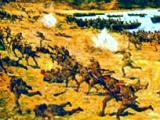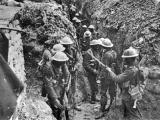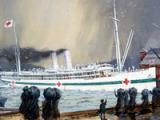Casualties
Articles
First World War memorials

The New Zealand war memorials of the First World War have become part of the common fabric of our lives, like stop signs or lamp-posts. Virtually every township in the country has one, usually in the main street. Read the full article
Page 2 - Remembering the dead
430 war cemeteries in Northern France, Belgium and the UK and more than 500 public memorials in New Zealand serve as permanent reminders of the terrible toll of the First World
The Gallipoli campaign

Each year on Anzac Day, New Zealanders (and Australians) mark the anniversary of the Gallipoli landings of 25 April 1915. On that day, thousands of young men, far from their homes, stormed the beaches on the Gallipoli Peninsula in what is now Türkiye. Read the full article
Page 6 - Evacuation
Hill 60 was the last major Allied attack at Gallipoli. The failure of the August offensive raised more questions about the future of the campaign, especially in light of the
The Merchant Navy

3 September is Merchant Navy Day, which was first officially commemorated in New Zealand in 2010. The date marks the sinking of the first Allied merchant ship in 1939, just hours after the Second World War began. This is the story of the 'fourth service' at war. Read the full article
Page 6 - Roll of Honour, 1939-45
This roll lists the names of seafarers who died while serving on New Zealand merchant ships and New Zealanders known to have been lost while sailing under the flags of other
First World War - overview

Archduke Franz Ferdinand, heir to the throne of the Austro-Hungarian Empire, and his wife Sophie were assassinated in the Bosnian city of Sarajevo. This was a key event in sparking the Great War of 1914–18. Read the full article
Page 1 - New Zealand and the First World War
Archduke Franz Ferdinand, heir to the throne of the Austro-Hungarian Empire, and his wife Sophie were assassinated in the Bosnian city of Sarajevo. This was a key event in
Page 5 - The war at home
New Zealand played a small but useful part in the British Empire's war effort, and its essential war aim was achieved with the defeat of Germany and its allies in late 1918. New
1916: Armentières and the Battle of the Somme

Following the Gallipoli withdrawal, the newly formed New Zealand Division left for France in early April 1916. Sent to the Flanders region to gain front-line experience, they spent the next three months guarding a ‘quiet’ or ‘nursery’ sector of the line at Armentières before moving south to the Somme battlefields and their first large-scale action on the Western Front. Read the full article
Page 1 - The Battle of the Somme
Following the Gallipoli withdrawal, the newly formed New Zealand Division left for France in early April 1916. Sent to the Flanders region to gain front-line experience, they
Korean War
New Zealand was involved militarily in Korea from 1950 to 1957, first as part of the United Nations 'police action' to repel North Korea's invasion of its southern neighbour, and then in a garrison role after the armistice in July 1953. Read the full article
Page 8 - Korean War Roll of Honour
Roll of Honour of New Zealanders killed during the Korean War,
Passchendaele: fighting for Belgium
Ever since 1917 Passchendaele has been a byword for the horror of the First World War. The assault on this tiny Belgian village cost the lives of thousands of New Zealand soldiers. But its impact reached far beyond the battlefield, leaving deep scars on many New Zealand communities and families. Read the full article
Page 1 - Passchendaele: fighting for Belgium
Ever since 1917 Passchendaele has been a byword for the horror of the First World War. The assault on this tiny Belgian village cost the lives of thousands of New Zealand
Page 3 - The Passchendaele offensive
The failed attempt to capture the town of Passchendaele saw more New Zealanders killed in one day than in any other military campaign since
Page 5 - The human impact
One in four New Zealand men aged 20–45 was either killed or wounded in the First World War, but the impact of the war reached far beyond these individuals and directly affected
Page 6 - Helping the wounded
More than 14,000 New Zealanders were wounded between June and December 1917 in Belgium, and medical staff, orderlies, chaplains and stretcher-bearers worked round the clock to
Passchendaele activities
Why do the events at Passchendaele in October 1917 go largely unnoticed in the New Zealand calendar? Can a case be made for reconsidering the place of Anzac Day in our national calendar? Read the full article
Page 2 - Remembering the dead
Acknowledging the sacrifices of those who served or died was an important way for communities, including schools, to make sense of the human cost of
Merchant marine
On 3 September New Zealand honours Merchant Navy Day. Here we explore the little-known but vital role played by the merchant marine during the First World War, when these civilian seafarers often found themselves in the front line of the war at sea. Read the full article
Page 4 - Hospital ships
In May 1915, as casualties mounted at Gallipoli, the government chartered a hospital ship, the Union Company's 5282-ton trans-Tasman liner
Page 6 - Agony on the Aparima
One of the worst losses of New Zealand lives at sea occurred on the Union Company’s Aparima in
Featherston camp
History of the military training camp at Featherston during the First World War Read the full article
Page 2 - Featherston camp death register 1915–19
A transcript of the Featherston Camp death register from the First World
Hospital ships

The Maheno and Marama were the poster ships of New Zealand's First World War effort. Until 1915 these steamers had carried passengers on the Tasman route. But as casualties mounted at Gallipoli, the government - helped by a massive public fundraising campaign - converted them into state-of-the-art floating hospitals. Read the full article
Page 4 - Civilians at Gallipoli
The Maheno arrived in the Mediterranean in time for the Allies’ bloody late August 1915 offensives to find that not much had improved since the April
Page 6 - Later service and legacies
The Marama missed Gallipoli, reaching the Mediterranean a few weeks after the Allies abandoned the peninsula. The ships’ service pattern would now be dominated by long voyages
1918: Spring Offensive and Advance to Victory
In 1918, a series of major German and Allied offensives broke the stalemate of trench warfare on the Western Front, resulting in the collapse of the German Army and the end of the war within the year. New Zealand units played an important part in the Allies' final push for victory. Read the full article
Page 1 - 1918: spring offensive and advance to victory
In 1918, a series of major German and Allied offensives broke the stalemate of trench warfare on the Western Front, resulting in the collapse of the German Army and the end of the
Rolls of honour and obituaries
Government rolls of honour and obituaries published at the end of the First World War. Read the full article
Page 8 - Education service Roll of Honour
Roll of honour for education service employees killed in the First World































